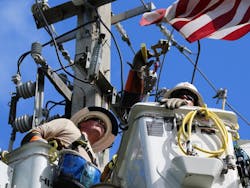With power still not fully restored, Puerto Rico finds itself forced to quickly answer questions about microgrids that much of the U.S. mainland has yet to tackle.
How many microgrids are enough? What’s the utility role? What price should customers pay for microgrid power? How green should they be? And what defines a microgrid, anyway?
These questions are being debated in a proceeding before the Puerto Rico Energy Commission, which released draft regulations for microgrid development on January 3. Many microgrids have been installed on the island since September when Hurricane Maria destroyed most of the power grid. More are coming, and the commission is trying to set ground rules.
Not surprisingly, the proceeding is drawing influential organizations and companies that are developing microgrids nationally and in some cases internationally.
What’s decided could have meaning well beyond Puerto Rico, given the lack of precedent that now exists governing microgrid development, according to the Sierra Club of Puerto Rico.
“We believe that the silver lining to the destruction caused by Hurricanes Irma and Maria is that Puerto Rico can be a leader across the hemisphere in the creation and regulation of a 100 percent clean and renewable electric system, with microgrids as a key component,” said the organization in comments filed before the commission.
Utility says stop
But slow down, says the Puerto Rico Electric Power Authority (PREPA), the island’s financially beleaguered utility.
PREPA says that this is the wrong time to institute new microgrid policy, and acting in haste could cause “serious harm.” In a filing before the commission, the utility cites the potential for stranded costs, jurisdictional and legal violations, operational problems, interference with restoration efforts, cherry picking of customers by private developers, the rise of mini-grids, and other issues that could undermine PREPA as it attempts to move out of its deep debt.
“In short, however much benefit microgrids hold, getting it wrong can cause serious harm to customers, the utility, and Puerto Rico as a whole,” PREPA said.
The utility called for the commission to dismiss the proceeding or at least delay it until it can be “synced” with the utility’s larger financial and resource planning.
Others say go
Meanwhile, others see the commission as acting too conservatively.
The Institute for Energy Economics and Financial Analysis (IEEFA), an Ohio-based group “welcomes the urgency” to bring clear rules on decentralized energy to the U.S. territory – but says it’s just the start.
“More could be done to facilitate the deployment of microgrids, especially for critical loads and for areas that have not yet received power after Hurricane Maria,” IEEFA said. “We urge the commission to take additional steps, via a separate proceeding, to proactively encourage the development of microgrids in Puerto Rico.”
Among other things, IEEFA recommended that the commission identify targeted sites for microgrids, based on critical loads, potential for combined heat and power (CHP), geographic location or other criteria.
Several companies and organizations championed the commission’s efforts, but asked for adjustment in aspects of its plan. Of particular concern is a cap the commission proposed on what microgrids can charge customers.
How to price service from microgrids
For microgrids developed by third parties, the draft rule limits prices to PREPA’s average electric rates. Critics argued that by doing so, the commission fails to take into account that microgrids might cost more, but provide greater benefits than grid power. Microgrids, for example, keep power flowing to customers by islanding when the central grid fails. They also can supplant polluting energy with renewables.
In addition, building microgrids in the island’s remote and difficult terrain is more costly than doing so in the cities.
“It makes sense that microgrid systems should have rates that are similar to what the grid typically provides (sometimes less as in the case of our Boston HQ microgrid),” Schneider Electric wrote. “However, there will be exceptions in Puerto Rico where critical infrastructure facility in a particularly remote area either has no access to reliable transmission lines or has other limitations that on one hand make a microgrid necessary, but on the other drive the cost up.”
Pricing for microgrids in Puerto Rico will only become clear as projects are developed, Schneider said, adding: “We don’t want these systems to be perceived as expensive gimmicks, but we also need to be realistic about costs of systems on the island, especially when we don’t know how fast they will scale.”
“We don’t want these systems to be perceived as expensive gimmicks…”
Sunrun, which has been donating solar plus storage for Puerto Rico’s fire departments, suggested that the microgrid rules rely more on competitive pricing.
As a general principle, Sunrun advocates that “where a ratepayer has the ability to choose a competitive option, such as third-party owned solar and storage, no price regulation is warranted. Price regulation is a substitute for market competition,” said the company, which has been working on the island in partnership with non-profit Empowered by Light and Puerto Rico construction firm Aireko.
Tesla suggested using a cost-benefit analysis, instead of PREPA’s average rate, as the basis for setting pricing. For example, if a microgrid is built to serve a remote community, the utility can avoid the cost of extending utility distribution lines to the region. That avoided cost might be a more realistic benchmark than the utility’s average rate.
“By definition, many of the customers who will be served by microgrids will also be among the most expensive for PREPA to serve, making the average PREPA rate an inaccurate benchmark,” Tesla said.
Tesla also pushed for a change in the way the commission defines microgrids, so that it includes off-grid microgrids, not just those intended to connect to PREPA’s grid.
Bringing greater efficiency to microgrids
The Natural Resources Defense Council suggested the commission require that microgrids incorporate energy efficiency measures, in particular a completed energy audit for each building that is an owner or customer for the microgrid.
The U.S. Green Building Council advised that Puerto Rico adopt a third-party certification platform to ensure microgrids perform as expected. The council offers Performance Excellence in Electricity Renewal (PEER) for microgrids, which functions like its popular LEED program in rating green buildings.
The New York State Smart Grid Consortium focused on how the draft rules treat CHP. The organization suggested that CHP used in microgrids be required to meet an efficiency standard of at least 65 percent, as is the case in New York.
Bloom Energy urged the commission to revise the rules so that all-electric fuel cells can be used in microgrids, not just CHP fuel cells. The company argued that unlike CHP , all-electric fuels can be placed at sites without on‐site thermal load.
The microgrid industry’s focus on the proceeding brings both tremendous resources and complexity to the Puerto Rico’s microgrid undertaking. As the the Municipality of Bayamón summed it up, the commission “has embarked down an exceptionally complex road, at a critical moment in time.”
Microgrid 2018 will feature a session on microgrids in Puerto Rico. Register today for the May 7-9 conference in Chicago.







